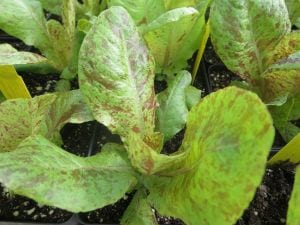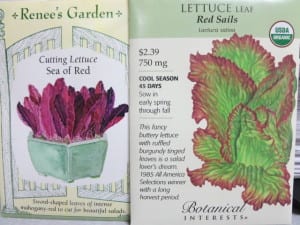Salad lovers get very excited when lettuce season arrives after the hot summer has passed. Air temperatures and soil temperatures are cool enough for lettuce seeds and lettuce transplants to be planted in San Antonio now. Our great selection of lettuce varieties at Rainbow Gardens makes getting excited about lettuce season pretty darn easy!
You can come grab a couple of your favorite lettuce transplant and try some of our new heirloom varieties too. Another great way to get your lettuce fix is to plant seeds continuously through the season; that way you will always have the opportunity to add something fresh from the garden to your meals. Let us take a closer look at lettuce. No more puns, I promise.
We have an abundance of lettuce transplants to choose from at Rainbow Gardens and you should definitely come see our selections, but today’s blog is all about planting lettuce by seed. Lettuce grows very easily from seed, so this is a great way to get a lot of lettuce from one small seed packet.




7 Steps for Planting Lettuce by Seed
(Your vegetable garden soil should already be weed-free, well tilled and prepped for planting lettuce and other fall veggies. If you need help with this task, you can access our Planting and Caring for Vegetables in San Antonio Guide here.)
1. Pour a little bit of seed into one hand and use your thumb and forefinger to sprinkle seeds along the top of the soil, as if you are sprinkling salt.
2. Lightly cover the seeds of lettuce with about ¼” of fine soil. You are not trying to bury your lettuce seeds, just covering them slightly so they don’t blow away. Sprinkle with water to settle them on the soil.
Extra tip: Plant a small amount of seeds to start. If you plant lettuce seeds successively every 10-14 days you can have a continuous harvest all season long.
3. Keep soil moist, but not soggy, throughout seed germination.
4. Continuous thinning of lettuce seedlings is key to healthy, vigorous plants. When seedlings grow to heights of about 4” and have 3-4 true leaves, thin lettuce seedlings to where there is 3 inches between plants.
As plants continue growing, keep thinning lettuce seedlings 6”, 12”, and finally to where there is 18” between mature plants. (You can transplant thinnings to another area of the garden, or eat them as tender baby lettuce.)
5. Side-dress your actively growing lettuce plants with a high nitrogen fertilizer for vigorous vegetative growth. Always water in fertilizer thoroughly, and do not let fertilizer sit on leaves.
6. Mulching lettuce will help prevent competing weeds and also helps with moisture conservation.
7. Harvest mature outer leaves from loose-leaf lettuce types as you need them, or you can also cut the entire plant down to about 1” above the soil. The plant should grow back. For head-type lettuce, wait until just before the entire plant has matured and cut the entire plant at soil level.
Fall is a great time for enjoying a vegetable garden. Lettuce is one of the easiest veggies to grow. We hope you will give it a try and become a lifelong fan.
~The Happy Gardener, Lisa Mulroy

